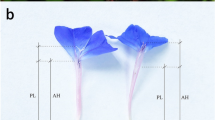Abstract
Eichhornia azurea (Pontederiaceae) is a mat-forming, clonal aquatic that inhabits lakes, marshes and river systems in many parts of the Neotropics. The species is tristylous with long-, mid-, and short-styled morphs commonly represented in natural populations. To investigate whether E. azurea possesses a trimorphic incompatibility system typical of tristylous species, we conducted a controlled pollination experiment on 15 clones representing the three style morphs from a natural population near Rosario, Argentina. Comparisons of fruit and seed set following self-, illegitimate, and legitimate pollinations clearly demonstrated the presence of trimorphic incompatibility in E. azurea. Self- and illegitimate pollinations produced significantly less fruit and seed than legitimate pollinations in all three style morphs. Pollen from the two anther levels within a flower exhibited contrasting compatibility relations in self-pollinations. In common with several other tristylous species in Pontederiaceae, the expression of self-incompatibility was weakest in the mid-styled morph and strongest in the short-styled morph. We discuss the ecological and evolutionary significance of the partial expression of trimorphic incompatibility in E. azurea.
Similar content being viewed by others
Author information
Authors and Affiliations
Additional information
Received: 3 May 1999 / Revision accepted: 27 July 1999
Rights and permissions
About this article
Cite this article
Bianchi, M., Vesprini, J. & Barrett, S. Trimorphic incompatibility in Eichhornia azurea (Pontederiaceae). Sex Plant Reprod 12, 203–208 (2000). https://doi.org/10.1007/s004970050001
Issue Date:
DOI: https://doi.org/10.1007/s004970050001




